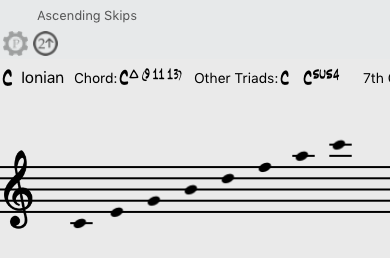![]() Step-Skip Patterns
Step-Skip Patterns
In Tessitura Pro we talk about STEP-SKIP PATTERNS but it is important to notice that we do not actually mean step as in “a major second” or skip as in a leap of a third .
You must remember that we are dealing with any kind of structure.
STEP : Always represented as 1up or 1down , is the next (or previous) note in the structure
SKIP : Any number above 1. i.e. 2up, 3up…7up, 2down, 3down…7down . i.e. A 2up skip means we are skipping the next note in the structure. In a C major scale a 2up from C would be the note E ( C D E ), but in a C major Triad a 2up from C would be G ( C E G )
REPEATED NOTES : Represented by the number 0
A step-skip pattern is then a vector (set of numbers) such as P=(1,-2) or it could be only P=(1) or more complex pattern P=(1,-2,3,1) which is then repeated in loop until the notes run out of range. Note: You can determine the range for you instrument or ask the patterns to only expand a range of 1 or 2 octaves
i.e If we apply the pattern (1) or 1up over the C we then get the C scale Ascending

i.e. A pattern (2) or 2up over the C will be the C scale in thirds ascending (since we are skipping a note every time)

But the pattern (1) or 1up over a C Major Triad will produce the C major arpeggio, since it creates the pattern by STEP UP meaning go to the next note in the structure

You may also add the Inversion or the Retrogradation at the end of the pattern, or both.
Here’s the previous pattern with the Inversion at the end. Now you can practice ascending/descending C Major Triad arpeggio

You may also harmonize target notes diatonically.
Read more under the Harmonizer section
Tessitura Pro by mDecks Music